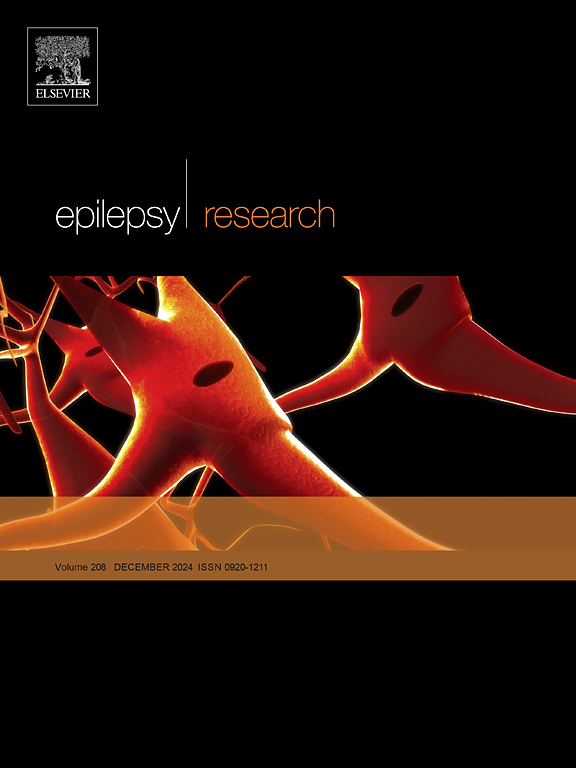中国癫痫患者抑郁症状:患病率及临床相关性
IF 2
4区 医学
Q3 CLINICAL NEUROLOGY
引用次数: 0
摘要
目的:抑郁症状是癫痫患者常见的合并症,显著影响癫痫患者的生活质量和治疗效果。本研究旨在探讨中国癫痫患者抑郁症状的患病率及临床相关因素。方法于2018年1月至2023年6月在北方战区总医院神经外科进行描述性横断面研究。16岁及以上的癫痫患者被纳入研究,但不包括那些患有严重疾病、药物滥用障碍或严重认知障碍的患者。使用标准化的临床数据收集表收集人口统计学和癫痫相关信息。使用贝克抑郁量表- ii (BDI-II)评估抑郁症状。采用SPSS 27.0进行统计分析。结果纳入513例癫痫患者,平均年龄37.48岁(SD= 15.09)。其中男性占65.9% %,年龄在40岁以上的占62.6 %。大多数患者为单身(50.9 %)和受过正规教育(57.1% %)。平均发病年龄21.96岁(SD= 12.83),平均发病时间11.02岁(SD= 13.64)。全身性强直-阵挛性发作是最常见的类型(62.0 %),32.7% %的患者经历过非常频繁的发作。63.5% %的患者采用综合治疗。137例患者出现抑郁症状,患病率为26.7 %(95 % CI: 20.51-31.89)。抑郁症状的严重程度分为轻度(62.0 %)、轻度至中度(18.2% %)、中度(10. %)和重度(9.5% %)。抑郁症状的患病率在女性、分居/丧偶个体、受教育程度较低的个体和失业患者中较高。发现抑郁症状与发作频率、发作持续时间和多种治疗之间存在显著关联。多变量分析确定癫痫发作频率、癫痫发作持续时间和多种治疗是抑郁症状的独立预测因子。结论抑郁症状在中国癫痫患者中非常普遍,抑郁症状与一些社会人口学和临床特征有显著相关性。常规抑郁症状筛查和量身定制的干预措施对于改善这一人群的生活质量和治疗效果至关重要。未来的研究应侧重于纵向研究,以探索因果关系并制定有针对性的干预措施。本文章由计算机程序翻译,如有差异,请以英文原文为准。
Depressive symptoms in Chinese patients with epilepsy: Prevalence and clinical correlates
Objective
Depressive symptoms were a prevalent comorbidity among patients with epilepsy, significantly impacting their quality of life and treatment outcomes. This study aims to investigate the prevalence and clinical correlates of depressive symptoms in Chinese patients with epilepsy.
Methods
A descriptive cross-sectional study was conducted at the Department of Neurosurgery, General Hospital of Northern Theater Command, from January 2018 to June 2023. Patients diagnosed with epilepsy aged 16 years or older were included, excluding those with severe illnesses, substance abuse disorders, or severe cognitive impairments. Demographic and epilepsy-related information was collected using a standardized clinical data collection form. Depressive symptoms were assessed using the Beck Depression Inventory-II (BDI-II). Statistical analyses were performed using SPSS version 27.0.
Results
The study included 513 patients with epilepsy, with a mean age of 37.48 years (SD= 15.09). Among these, 65.9 % were male, and 62.6 % were aged 40 years or older. The majority of patients were single (50.9 %) and had formal education (57.1 %). The mean age of epilepsy onset was 21.96 years (SD = 12.83), and the mean duration of illness was 11.02 years (SD= 13.64). Generalized tonic-clonic seizures were the most common type (62.0 %), and 32.7 % of patients experienced very frequent seizures. Polytherapy was used by 63.5 % of patients. Depressive symptoms were present in 137 patients, representing a prevalence of 26.7 % (95 % CI: 20.51–31.89). The severity of depressive symptoms was categorized as mild in 62.0 %, mild to moderate in 18.2 %, moderate in 10.2 %, and severe in 9.5 %. The prevalence of depressive symptoms was higher among females, separated/widowed individuals, those with lower educational attainment, and unemployed patients. Significant associations were found between depressive symptoms and seizure frequency, duration of seizures, and polytherapy. Multivariate analysis identified seizure frequency, duration of seizures, and polytherapy as independent predictors of depressive symptoms.
Conclusions
Depressive symptoms were highly prevalent among Chinese patients with epilepsy, with significant associations found between depressive symptoms and several sociodemographic and clinical characteristics. Routine screening for depressive symptoms and tailored interventions are crucial for improving the quality of life and treatment outcomes in this population. Future research should focus on longitudinal studies to explore causal relationships and develop targeted interventions.
求助全文
通过发布文献求助,成功后即可免费获取论文全文。
去求助
来源期刊

Epilepsy Research
医学-临床神经学
CiteScore
0.10
自引率
4.50%
发文量
143
审稿时长
62 days
期刊介绍:
Epilepsy Research provides for publication of high quality articles in both basic and clinical epilepsy research, with a special emphasis on translational research that ultimately relates to epilepsy as a human condition. The journal is intended to provide a forum for reporting the best and most rigorous epilepsy research from all disciplines ranging from biophysics and molecular biology to epidemiological and psychosocial research. As such the journal will publish original papers relevant to epilepsy from any scientific discipline and also studies of a multidisciplinary nature. Clinical and experimental research papers adopting fresh conceptual approaches to the study of epilepsy and its treatment are encouraged. The overriding criteria for publication are novelty, significant clinical or experimental relevance, and interest to a multidisciplinary audience in the broad arena of epilepsy. Review articles focused on any topic of epilepsy research will also be considered, but only if they present an exceptionally clear synthesis of current knowledge and future directions of a research area, based on a critical assessment of the available data or on hypotheses that are likely to stimulate more critical thinking and further advances in an area of epilepsy research.
 求助内容:
求助内容: 应助结果提醒方式:
应助结果提醒方式:


